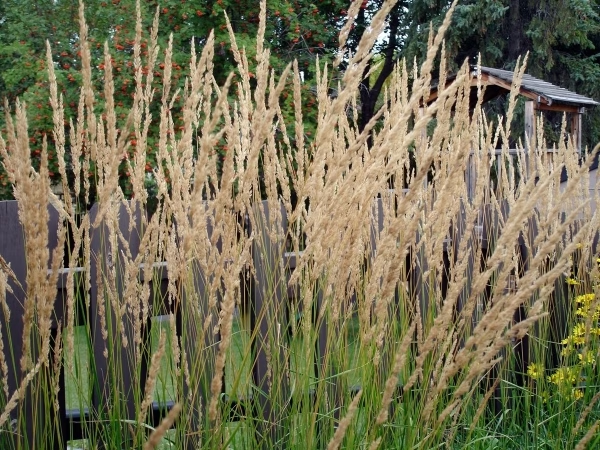
Feather Reed Grass
Botanical Name
:
Calamagrostis acutiflora
Plant Type
:
Ornamental grass
Seasons
:
Grows actively in spring and summer. Seed heads persist through fall but become dormant in winter
Sun Level
:
Full sun, at least 6 hours a day
Ideal Soil Temperature for Planting
:
65-75°F (18-24°C). Spring or early fall are ideal planting times
Soil Type
:
Rich, moist, well-draining soil
Hardiness Zones
:
4–9 (USDA)
Germination
:
Feather reed grass is usually not grown or propagated from its seeds because the plant is a hybrid. Feather is propagated by division or purchasing established plants
P.H. Level
:
6.0 to 7.0
Water/Irrigation
:
Water regularly during the first year to establish roots. Once established, it is relatively drought-tolerant but benefits from occasional watering during prolonged dry periods
Fertilization
:
Light application of balanced fertilizer in spring. Add organic mulch and compost to nutrient-poor soils
Habit
:
Upright, clumping, and columnar
Final Plant Height
:
3-6 feet (90-182 cm)
Spread
:
2-3 feet (60-90 cm)
Spacing
:
18-24 inches apart for a clumping effect
Flowers
:
Silky, plume-like flower heads in late spring to early summer
Attracts
:
Birds, especially for seed heads in fall and winter
Uses
:
Specimen plant, border, accent, or as part of a naturalistic garden
Companions
:
Consider plants with contrasting textures and colors, such as coneflowers (Echinacea), sedum, or daylilies
Pruning
:
To avoid damaging the new growth, cut back the stems to about 6 inches annually in late winter or very early spring
Toxicity
:
Non-toxic to humans and pets
Pests
:
Minimal, but can occasionally attract aphids or spider mites
Diseases
:
Generally disease-resistant, but can suffer from rust in humid conditions
Expert Care Tips
:
- Divide the plant every 2-3 years to prevent overcrowding and improve airflow
- Mulch around the base in winter to help protect roots from freezing
- Avoid heavy fertilization, which can lead to excessive foliage growth at the expense of flowers
- Cut back the plant in early spring to make way for new growth, leaving a few inches of the previous season’s growth to help insulate the roots
Botanical Name
:
Calamagrostis acutiflora
Plant Type
:
Ornamental grass
Seasons
:
Grows actively in spring and summer. Seed heads persist through fall but become dormant in winter
Sun Level
:
Full sun, at least 6 hours a day
Ideal Soil Temperature for Planting
:
65-75°F (18-24°C). Spring or early fall are ideal planting times
Soil Type
:
Rich, moist, well-draining soil
Hardiness Zones
:
4–9 (USDA)
Germination
:
Feather reed grass is usually not grown or propagated from its seeds because the plant is a hybrid. Feather is propagated by division or purchasing established plants
P.H. Level
:
6.0 to 7.0
Water/Irrigation
:
Water regularly during the first year to establish roots. Once established, it is relatively drought-tolerant but benefits from occasional watering during prolonged dry periods
Fertilization
:
Light application of balanced fertilizer in spring. Add organic mulch and compost to nutrient-poor soils
Habit
:
Upright, clumping, and columnar
Final Plant Height
:
3-6 feet (90-182 cm)
Spread
:
2-3 feet (60-90 cm)
Spacing
:
18-24 inches apart for a clumping effect
Flowers
:
Silky, plume-like flower heads in late spring to early summer
Attracts
:
Birds, especially for seed heads in fall and winter
Uses
:
Specimen plant, border, accent, or as part of a naturalistic garden
Companions
:
Consider plants with contrasting textures and colors, such as coneflowers (Echinacea), sedum, or daylilies
Pruning
:
To avoid damaging the new growth, cut back the stems to about 6 inches annually in late winter or very early spring
Toxicity
:
Non-toxic to humans and pets
Pests
:
Minimal, but can occasionally attract aphids or spider mites
Diseases
:
Generally disease-resistant, but can suffer from rust in humid conditions
Expert Care Tips
:
- Divide the plant every 2-3 years to prevent overcrowding and improve airflow
- Mulch around the base in winter to help protect roots from freezing
- Avoid heavy fertilization, which can lead to excessive foliage growth at the expense of flowers
- Cut back the plant in early spring to make way for new growth, leaving a few inches of the previous season’s growth to help insulate the roots
Written by Salome Wapukha – https://www.linkedin.com/in/salome-wapukha-556700193/

